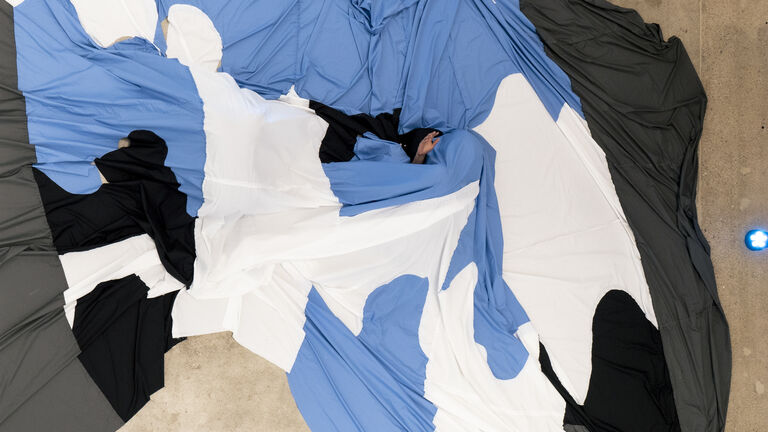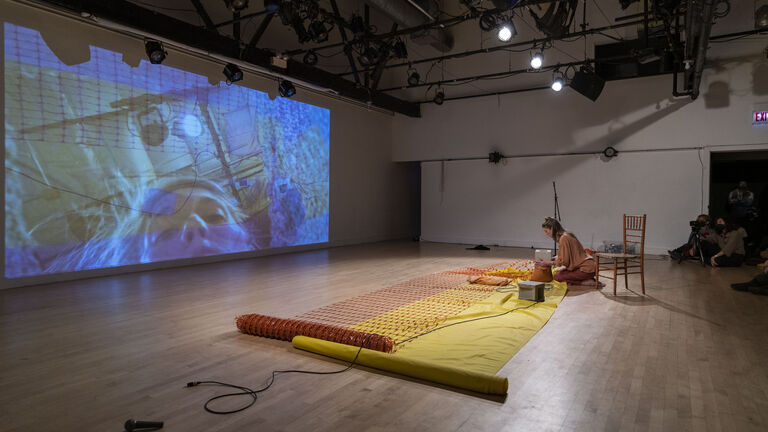
Andy Giovale BFA 23 Title: Sandtimer Photo Credit: Ruby Que
Undergraduate Overview
Undergraduate Overview
The School of the Art Institute of Chicago's (SAIC) Performance department is one of the only undergraduate contemporary performance departments in the country. We are known nationally and internationally as a center for engagement, research, and experimentation of body-focused performance art practice in an art-and-design school context.
We put a strong emphasis on contemporary art with practices and theories including:
- Live actions
- Interactive digital technologies
- Movement research
- Tactical and site performance
- Performance installation
- Abandoned practices
- Re-enactment/Reperformance
- Archiving the document
- Performance writing
The Performance program's distinguished and professionally active faculty represent a broad range of experimental performance approaches ranging from solo performance and material actions to activist participatory theater, gender performance, experimental movement performance, performance lectures, re-enactment, networked virtual performance/mixed reality, and curating.
Possible Performance Paths
Undergraduate students concentrating their BFA in Performance are encouraged to consider their art-making process as a interdisciplinary practice that can range across various departments including, but not limited to, Fiber and Material Studies; Sculpture; Performance; Fashion Design; Art and Technology / Sound Practices; Film, Video, New Media, and Animation; and Ceramics. Students are encouraged to confer with faculty to map a course of interdisciplinary study that reflects the latest developments in contemporary practices in these fields.
Below are some pathway suggestions to consider:
- Body/Performance: Intro to Performance; The Performing Body; Performing Next Feminisms; Movement Research/Improvisation; Bodies in Motion; Durations: Long, Medium, Short; and Movement/Presence: Body as Site
- Object Performance: Material Actions, Puppetry, and Performance and Event Production
- Media Performance: Performance Media; Mixed Reality Performance; Performance and Video; Live Presence/Virtual Spaces; Performing for the Camera; and Fusions: Film, Video, Performance
- Installation/Site-specific Performance: Site Practice; Tactical Performance; Event Production; and Performance Installation
- Collaborative Performance: Systems, structures: Methods of creation; Make it Strange; Collaboration/Directing for Performance; Group Work; and Between Theatre and Performance.
- Critical/Activist Social and Political Performance: Extreme bodies in Performance; Border Crossing; Performing Next Feminisms; and Tactical Performance
- Performance Writing: Body/Text; Performative Writing; Scripting/Acting for Performance; and Narrative in Performance
- Re-enactment/Reperformance: Parasitic Practices; Performing the Document; Performing Fictions; and Performance Documentation
Undergraduate Admissions Requirements & Curriculum Overview
-
To apply to the School of the Art Institute of Chicago (SAIC), you will need to fill out an application and submit your transcripts, artist's statement, and letters of recommendation. And most importantly, we require a portfolio of your best and most recent work—work that will give us a sense of you, your interests, and your willingness to explore, experiment, and think beyond technical art, design, and writing skills.
In order to apply, please submit the following items:
Bachelor of Fine Arts in Studio Portfolio
Submit 10–15 pieces of your best and most recent work. We will review your portfolio and application materials for merit scholarship once you have been admitted to SAIC.
When compiling a portfolio, you may concentrate your work in a single discipline or show work in a breadth of media. The portfolio may include drawings, prints, photographs, paintings, film, video, audio recordings, sculpture, ceramics, fashion designs, graphic design, furniture, objects, architectural designs, websites, video games, sketchbooks, scripts, storyboards, screenplays, zines, or any combination of the above.
Learn more about applying to SAIC's Bachelor of Fine Arts in Studio, or view our portfolio preparation guide for more information.
-
Studio 69 - CP 1010 Core Studio Practice I (3)
- CP 1011 Core Studio Practice II (3)
- CP 1020 Research Studio I (3)
- CP 1022 Research Studio II (3)
- SOPHSEM 2900 (3)
- PROFPRAC 3900 (3)
- CAPSTONE 4900 (3)
- Studio Electives (48)
PROFPRAC and CAPSTONE are now required for new incoming students beginning in the 2015-16 academic year.
Art History 15 - ARTHI 1001 World Cultures/Civilizations: Pre-History—19th Century Art and Architecture (3)
- Art History Elective at 1000 level (3)
- Art History Electives (9)
Liberal Arts 30 - ENGLISH 1001 First Year Seminar I (3)
- ENGLISH 1005 First Year Seminar II (3)
- Natural Science (6)
- Social Science (6)
- Humanities (6)
- Liberal Arts Electives (6)
General Electives 6 - Studio, Art History, Liberal Arts, AAP, or EIS
Total Credit Hours 120 * BFA students must complete at least 6 credit hours in a class designated as "off campus study." These credits can also fulfill any of the requirements listed above and be from any of the divisions (Art History, Studio, Liberal Arts, or General Electives).
BFA With Distinction—SAIC Scholars Program: The SAIC Scholars program is a learning community of BFA students pursuing rigorous study in both their academic coursework and their studio pathways. There are two opportunities for interested students to apply to the SAIC Scholars Program: at the time of admission to the school, and after they have completed 30 credits of study at SAIC. Students pursuing the latter option are required to formally submit an application to the Undergraduate Division. Once admitted to the SAIC Scholars Program, students are required to successfully complete a minimum of six designated scholars courses. Students who complete the program will graduate with distinction.
BFA in Studio with Thesis Option (Liberal Arts or Visual Critical Studies): BFA students may complete a nine-credit, research-based academic thesis as part of their studies within the 126 credits for the BFA in Studio degree. BFA with Thesis course sequences are offered over 3 semesters through the departments of Liberal Arts or Visual and Critical Studies (VCS). Students who are interested in one of the thesis options should follow the steps outlined below in the beginning of the junior year.
Requirements for the BFA: Studio Art with Liberal Arts Thesis
Step One: Students are required to meet with the Chair of the Liberal Arts department in the beginning of their junior year.
Step Two: With the Department Chair's approval, the student enrolls in the following courses beginning in the spring term of their junior year:
- SOCSCI or HUMANITY 3900 Academic Research and Writing (3 credits)
- LIBARTS 4800 Undergraduate Thesis: Research/Writing I (3 credits)
- CAPSTONE 4900 Liberal Arts Undergraduate Thesis: Research/Writing II (3 credits)
Step Three: The completed thesis must be approved by both the Thesis II instructor and the Chair of Liberal Arts. Students must make a formal presentation and participate in the Undergraduate Thesis Symposium in their senior year.
Requirements for the BFA: Studio Art with Visual and Critical Studies (VCS) Thesis
Step One: Students are required to meet with the Visual and Critical Studies Undergraduate Coordinator in or by the beginning of their junior year.
Step Two: With the VCS Coordinator's approval, the student enrolls in the first of the three-course sequence beginning in the spring term of their junior year:
- VCS 3010 Tutorial in Visual & Critical Studies (3 credits)
- VCS 4800 Undergraduate Thesis Seminar: Research & Writing I (3 credits)
- CAPSTONE 4900 VCS Undergraduate Thesis Seminar: Research & Writing II (3 credits)
Step Three: Completion of thesis must be approved by both the Thesis II instructor and the VCS Undergraduate Coordinator. Students must make a formal presentation and participate in the Undergraduate VCS Thesis Symposium in the senior year.
Total credits required for minimum residency 60 Minimum Studio credit 42
Course Listing

Freshman and Transfer Deadline: June 1
Camille Casemier, “Wait, Weight Sit.” Photo by Eugene Tang